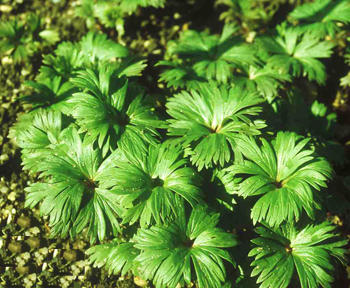Contents:
Common Names | Parts Usually Used | Plant(s) & Culture | Where Found | Medicinal Properties | Biochemical Information
Legends, Myths and Stories | Uses | Warning | Bibliography
Scientific Names
 |
- Aconitum napellus L.
- Ranunculaceae
- Buttercup family
Common Names
- Aconite
- Friar’s cap
- Mousebane
- Wolfbane
Parts Usually Used
Leaves, root
Back to Top
Description of Plant(s) and Culture
 |
Monkshood is a European erect, clump-forming perennial plant up to 4 feet tall; the tuberous root produces an erect, simple, glabrous or slightly hairy stem with alternate, palmately 5 to 7 lobed leaves that are dark green on top and paler beneath. The hood-like, blue-purple flowers grow in long, irregular racemes from June to August. Not heat tolerant, needs full sun or partial shade.
Other varieties: Monk’s cowl (A. carmichaelii) is native to the Szechuan region of China; it is used as a narcotic and as a topical anesthetic ointment in Chinese and homeopathic medicine, but it is too powerful for the home gardener to use.
Wolfsbane (A. lycoctonum) has yellow flowers and is familiar from folktales; old superstition held that it repelled werewolves.
Back to Top
Where Found
Cultivated in gardens in the United States and Canada.
Back to Top
Medicinal Properties
Analgesic, anodyne, cardiotonic, febrifuge, sedative, stimulant
Back to Top
Biochemical Information
Aconitine, one of the fastest acting and deadliest alkaloids known
Back to Top
Legends, Myths and Stories
Various species of monkshood grow wild in North America, particularly in mountainous regions. These are similarly poisonous.
Used as a poison in hunting and war in Europe and Asia since ancient times, monkshood has acquired an extremely bad image through the ages. Its juice was used by soldiers to poison water supplies in the path of advancing enemies, and by hunters to poison spears, arrowheads, and bait.
In Greek legend, monkshood originated from the foam dripping from the fangs of the three-headed dog Cerberus that Herakles (Hercules) brought up from the underworld. Also Hecate, the Greek goddess of the moon, ghosts, witches, and magic, poisoned her father with monkshood.
In the Middle Ages witches were associated with monkshood. Since it numbs the senses and gives a sensation of flying, they are said to have smeared it on their bodies and broomsticks.
The name monkshood comes from its hood-shaped flowers.
A. napellus, monkshood, is the source of the drug aconite; it was formerly used to make a deadly poison; Shakespeare’s Romeo killed himself with a cup of it.
Back to Top
Uses
Monkshood is sometimes used for the pains of neuralgia, sciatica, and arthritis, gout, rheumatism, pneumonia, measles, nervous fever, and chronic skin problems.
Monkshood is among the most poisonous of plants. Small doses can cause painful death in a few hours. Do not use without medical supervision under any circumstances.
Back to Top
Warning
Monkshood is among the most poisonous of plants. Small doses can cause painful death in a few hours. Do not use without medical supervision under any circumstances.
Back to Top
Bibliography
![]() The Herb Book
The Herb Book, by John Lust, Bantam Books, 666 Fifth Avenue, New York, NY. copyright 1974.
Herbal Gardening, compiled by The Robison York State Herb Garden, Cornell Plantations, Matthaei Botanical Gardens of the University of Michigan, University of California Botanical Garden, Berkeley., Pantheon Books, Knopf Publishing Group, New York, 1994, first edition
![]() The Nature Doctor: A Manual of Traditional and Complementary Medicine
The Nature Doctor: A Manual of Traditional and Complementary Medicine, by Dr. H.C.A. Vogel; Keats Publishing, Inc., 27 Pine Street (Box 876) New Canaan, CT. 06840-0876. Copyright Verlag A. Vogel, Teufen (AR) Switzerland 1952, 1991
![]() Planetary Herbology
Planetary Herbology, by Michael Tierra, C.A., N.D., O.M.D., Lotus Press, PO Box 325, Twin Lakes. WI 53181., Copyright 1988, published 1992
![]() Webster’s New World Dictionary
Webster’s New World Dictionary, Third College Edition, Victoria Neufeldt, Editor in Chief, New World Dictionaries: A Division of Simon & Schuster, Inc., 15 Columbus Circle, New York, NY 10023
 The Rodale Herb Book: How to Use, Grow, and Buy Nature’s Miracle Plants (An Organic gardening and farming book)
The Rodale Herb Book: How to Use, Grow, and Buy Nature’s Miracle Plants (An Organic gardening and farming book), edited by William H. Hylton, Rodale Press, Inc. Emmaus, PA, 18049., 1974
